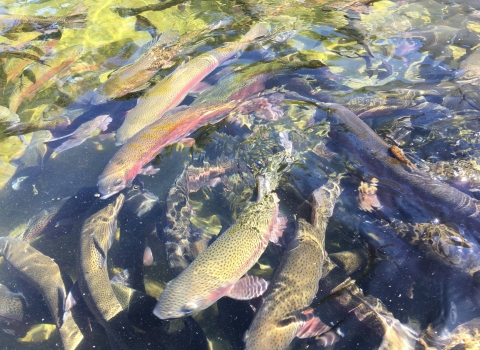Hautmans acrylic painting of a northern pintail bested 316 other entries and will become the 2001-2002 Federal Duck Stamp, which goes on sale July 1, 2001. The Federal Duck Stamp Contest is sponsored each year by the U.S. Fish and Wildlife Service.
All waterfowl hunters age 16 and older are required to purchase and carry Duck Stamps. Ninety- eight percent of the proceeds from the $15 Duck Stamp goes into the Migratory Bird Conservation Fund, which purchases wetlands for the National Wildlife Refuge System.
This is the second time Hautman has won the Federal Duck Stamp Contest; in 1996 his painting of a Canada goose took top honors.
Second place in this years Federal Duck Stamp Contest went to Gerald Mobley, of Broken Arrow, Oklahoma, for his acrylic rendering of a pintail. Mobley won the Federal Duck Stamp Contest in 1984.
Winner Bob Hautmans brother, Joe, captured third place with an acrylic painting of a pintail. Joe Hautman is also a veteran among Duck Stamp artists, having won the contest in 1992. Bob Hautman said he chose his winning design from among several sketches and spent two months working on the painting. He said he painted the northern pintail because of the species beauty.
"Theyre just such striking birds, I thought this would be a nice one to do," Hautman said. "I think theyre one of the most beautiful birds, and I thought it would be fun to paint."
A medium-sized dabbling duck, the northern pintail ranges across the Western hemisphere, from the Arctic to South America, though it breeds primarily in the grasslands of the northern Great Plains in the United States and Canada. Most pintails winter in much of the southern United States, concentrating primarily in California, Texas and Louisiana and further south along both coasts of Mexico.
Pintails take their names from the males distinctive pointed tail. During winter through mid summer, males feature a pale gray bill with black stripe down the center, a dark brown head and a distinctive white neck, breast and belly with a white finger extending up the back of the neck to the rear part of the face. In late summer until October, males are in eclipse plumage and resemble the mottled brown females. The northern pintail has suffered persistent population declines since aerial surveys began in 1955, in large part as a result of loss of wetland and grassland habitat across their range. From a high of more than 10 million birds in the 1950s, breeding populations of northern pintails have fallen to approximately 2.9 million birds in the traditional aerial survey area, well under the historic average of nearly 4.4 million birds.
The top 20 painting from this years Federal Duck Stamp Contest will be displayed at the Easton Waterfowl Festival in Easton, Maryland, November 10-12. They will also appear at the Wildlife West Festival in Redlands, California, later this month.
Eligible species for this years contest were the American green-winged teal, black duck, northern pintail, ruddy duck and American wigeon. Next year the only eligible species will be the black scoter; by the year 2002, all North American waterfowl species will have appeared on the Duck Stamp at least once.
The Federal Duck Stamp Contest is the nations only federally-sponsored art competition. No cash prize is awarded, but winning can boost the professional reputation of even a previously unknown wildlife artist. Winning artists stand to make hundreds of thousands of dollars from the sale of limited editions of prints of their Duck Stamp designs.
In addition to waterfowl hunters, stamp collectors, wildlife art lovers, and conservationists also buy Duck Stamps to add to their collections, enjoy as a miniature work of art, or as a simple way to support conservation. Duck Stamps can also be used to gain admission to those national wildlife refuges that charge entry fees.
Duck Stamps bearing this years winning design will go on sale at post offices, national wildlife refuges, some national retail chain stores, and various sporting-goods stores nationwide July 1, 2001. The 2001-2002 Duck Stamp will be available at select locations in both a self-adhesive format and the traditional gummed format. The Duck Stamp may also be purchased directly from the Federal Duck Stamp Office.
The U.S. Fish and Wildlife Service is the principal Federal agency responsible for conserving, protecting and enhancing fish, wildlife and plants and their habitats for the continuing benefit of the American people. The Service manages the 93-million-acre National Wildlife Refuge System which encompasses more than 530 national wildlife refuges, thousands of small wetlands and other special management areas. It also operates 66 national fish hatcheries, 64 fishery resource offices and 78 ecological services field stations. The agency enforces Federal wildlife laws, administers the Endangered Species Act, manages migratory bird populations, restores nationally significant fisheries, conserves and restores wildlife habitat such as wetlands, and helps foreign governments with their conservation efforts. It also oversees the Federal Aid program that distributes hundreds of millions of dollars in excise taxes on fishing and hunting equipment to state fish and wildlife agencies.
-FWS-
Editors Note: Black-and-white glossy prints and color slides are available on loan from the Fish and Wildlife Services Duck Stamp Program Office, 202-208-4354.
Photos of the 1st, 2nd and 3rd place art are also available on the Internet at http://duckstamps.fws.gov"> (jpeg format).
LinksU.S. Fish and Wildlife Service Home Page
Federal Duck Stamp Office Home Page


